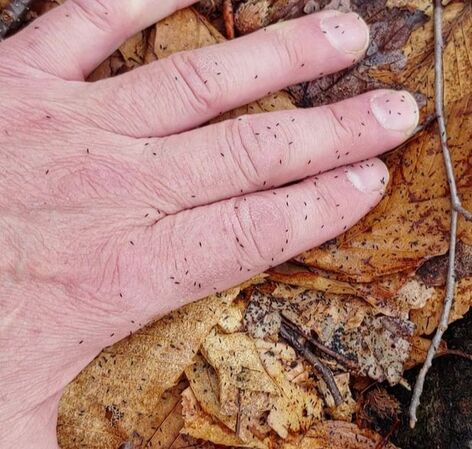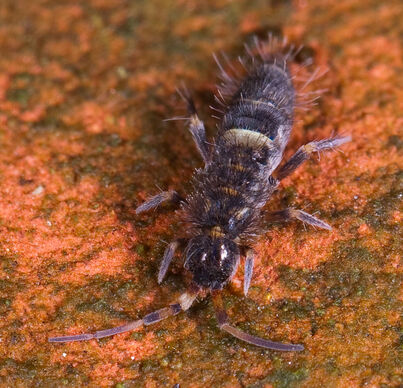|
On warm, sunny winter days, hikers often notice them jumping about on the snow. Their black bodies, jumping behavior, and sheer numbers--there can be thousands of them in just one square meter--really make them stand out. On the other hand, when temperatures drop, you may walk right by millions of them frozen or torpid and mistake them for flecks of dirt on the snow. You probably trample them en masse while hiking, and aren't even aware of it. Although they're commonly called "snow fleas" because of their prodigious jumping (the human-scale equivalent would be a leap of nearly 1,000 feet!), they don't bite, exist year-round in the soil, and aren't related to fleas. In fact, they aren't even true insects. They're Springtails (Collembola, from the class Entognatha, a divergent lineage of Hexapoda, which insects also belong to) and are considered to be the most abundant non-microscopic animal on earth. Springtails eat detritus in the soil and leaf litter, where they live mostly hidden to the human eye unless they venture out on the surface of the snow, or migrate. Yes, migrate. For reasons not understood, vast numbers of springtails--in areas spanning many square miles-- spontaneously move to the surface and begin to travel. In my 30+ years of hiking, I've witnessed this only three times in my life. Look down and your shoes and legs are covered with them. Put your hand down, and they blacken your hand. Stop in your tracks and you can hear them rustling in the leaves, a susurrus of white-noise. Although some people find their contact itchy, they are harmless and incapable of biting. In fact, they're a critical component of healthy soils and exist wherever soil exists. Here in New England, there can be 30-40 species of springtail in any given patch of soil. The blue-black springtail (Hypogastrura nivicola) is the species most commonly found hopping around on the snow. An organic antifreeze in their blood allows them to survive on ice and snow when there is enough solar gain to warm them. No one knows why they emerge and jump about on the snow--it's one of the great mysteries of the forest. --Paul-William
2 Comments
|
TOPICS
All
Humor (The Parsnip)

|
Proudly powered by Weebly


 RSS Feed
RSS Feed
